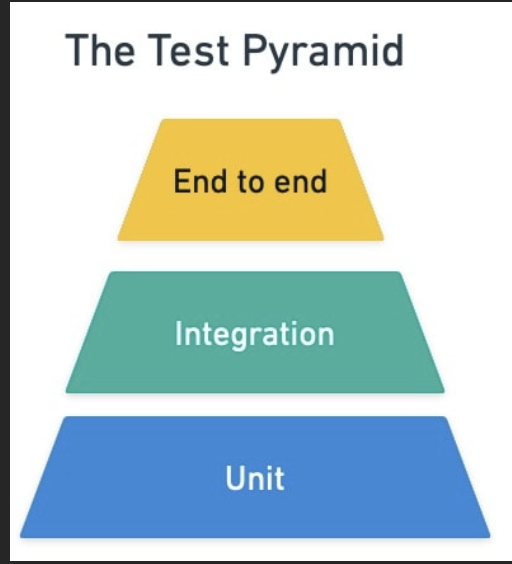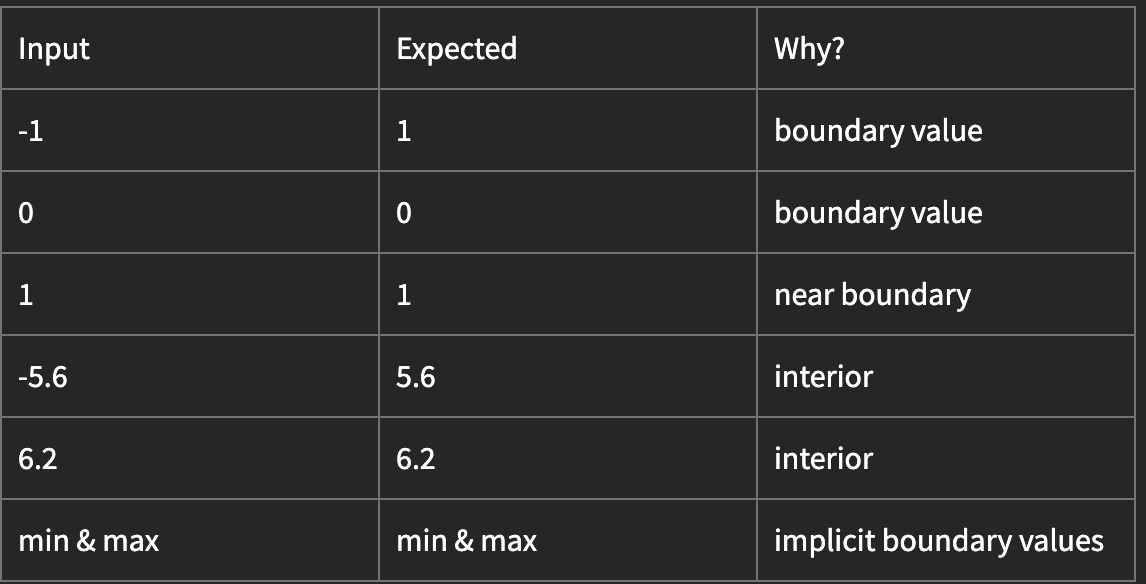dom lizarraga
Rails Testing | University of Waterloo
This is a series of lectures about rails testing -Databases & Software Engineering course.

How to test?
Mike Cohn in his book Succeeding with agile.
You should spend most of your time in Unit.
End to end is manual and it means a person goes through all the user flow to reach a user acceptance criteria, click buttons, links, add stuff to the shopping cart, make a payment.
This can be Manual test, actually using the interface, this is what the customer will see/use.
Template: Given: that I’m a logged in user in “home page” When: when I click on “log out” Then: I’m logged out
Only the basics here, for example: I can create an account but don’t extensively, send an email, one happy path and one sad path.
In Rails End to end tests are called system tests
Integration, tests multiple components but exclude user interface.
In Rails it tests the controller. what does it respond? what does it send?
POST to this path with this params (we can see if a form is going to the right path)
Unit, it isolates one single object or method from the rest of the system and test it by itself. This help us see where the problem is.
Models, and classes we create,
First I need to make sure my individual pieces work, then i put them together and see if that larger system works and eventually we’re going to check out and test the whole entire system.
Testing Pyramid and Rails Video Lecture
MSCI 245 : Testing
Is my app free of bugs? Does the program work as specified? Write a specification or a test that specifies expected behavior.
Test case: average_rating
Arrange - what is the input? Act - run the program Assert - check the output against the expected output
Then we need 2 cases:
- For a Book with 1 or more rating, it should return the average of that book’s ratings
- known gotchas: integers vs float division, off by one (when you skip 1st element of the loop).
- For a Book with 0 rating, it should return nil
This is the arrange Bob rated 5 Sue rated -2 Ali rated 4 total 7
Run the program total 7 / 3 = 2.333
Assert total vs expected_value
https://www.youtube.com/watch?v=2yYSR6ftxUo
Testing fundamentals - equivalence classes
You cannot test all inputs. You need to carefully pick inputs to find your mistakes.
“… testing can be used very effectively to show the presence of bugs, but never to show their absence” E.W. Dijkstra
if 2 inputs produce the same output, they are said to be member of the same equivalence class.
if the net method is tested correctly, the behavior of the method should be the same, there are only 2 inputs that we must use: [1, 2, 3] and [0, -12]
def absolute_value(x)
if x <= 0
return -1 * x
else
return x
end
end
Interior & boundary values.
Values that sit on either side of a division between equivalence classes are boundary valuer -> where bugs hide.
Other values are the interior values.
[minimum... -1]|[0 ... maximum]
the boundary is between -1 and 0
Test cases: (try to put all below in just one test)

Equivalence test case
min(a, b)
Test:
- a == b
- a < b
- a > b https://www.youtube.com/watch?v=-1kCdERz1sM
Base, Edge, and Corner Cases; Happy and Sad Paths
Base case - normal expected inputs Edge case - inputs approach limits or outside limits Corner case - crazy values, should never see in real world
Example: user interface - e commerce - shopping cart
Base -> user adds a few items Edge -> user surprises us with a large order 100-1000 things Corner -> whole store in cart (we don’t want the whole site to fail, we should put a limit)
We can think of a form for creating a user name, nick names, emails, domains, capitalization
Success & failure (code should handle both)
Test both good input (success).
Test bad inputs (failure) to test proper error handling.
Black box, you test the software and don’t get a look at the code, you cannot call the code
White box, you test the software and get a look at the code to see what is happening
https://www.youtube.com/watch?v=NoP3am8ipYw
Hunting for bugs
Logic errors
- boundaries
- common inputs to test
- some minimum
- zero
- one
-
empty - zero length list empty - negative numbers
- first/last element of an array
Most common working with arrays or any sort of list:
- skip first/last element
- don’t process last element
Numerical erros
- accidental truncation of floating point to integer
- divide by zero (think of a way how a user can input a 0 as denominator and catch the error)
- bad floating behavior (try to add a lot of small numbers to a larger numbers)
- assume the sum of the computer is correct
- sqrt(2) != √2
Integrating boundaries
- one system talking to another
- misunderstandings about proper inputs/outputs
Other
- null values -nil
- handling of exceptions
- loss of networks/disk/power?
https://www.youtube.com/watch?v=crFl2K1bOhI
MSCI 245 : A quick intro to Minitest and automated testing
- testing framework
- enabled by default in Rails
- automated testing at 3 levels
- Unit (individual methods or objects, this part works correctly)
- Controller (integration) (we reproduce a browser with http verbs POST, GET)
- System - end to end (E2E) user interface (manual, buttons)
To do unit testing we make a class that inherits from ActiveSupport::TestCase. We make one test case for every class we want to unit test.
test/models/book_test.rb
Arrange
Act
Assert
require 'test_helper' # brings test/test_helper.rb
class BookTest < ActiveSupport::TestCase
# (always start with "test_")
# The DB within test is empty
def test_average_rating_multiple_ratings
# you have to build up the case in the database
card = Author.create!(name: "Orson Scott Card") arrange
ender_game = Book.create!(title: "Ender's Game", year: "1985", author: card arrange
...
... add ratings/ users
assert_in_delta(2.333, ender_game.average_rating, 0.001, "should return 2.333 for Ender's Game")
end
def test_average_rating_no_ratings
christie = Author.create!(name: "Agatha Christie")
fire_pigs = Book.create!(title: "Fire Pigs", year: "1942", author: christie)
# first the expected, then the actual
assert_nil(fire_pigs.average_nil, "this should be nil")
end
Things to note:
- File that start with “test_” are run with “rails test”
- You can create other methods
- You have access to all Rails
- You can use debugger
- Each test should be independent of other tests
- You can define a setup method in the beginning and call it before every method, (to create data)
https://www.youtube.com/watch?v=JYbHurKGzM0
Testing - Test Cases - Minitest - Capybara
Arrange - setup the input code
Act - execute the code w/ input
Assert - check the result against our expected output
Example: we are testing addition, the input is 1 and 2, the expected result is 3.
E2E or systems tests:
Arrange - sometimes could be add items to DB Act - visit the home page, click a link to create account Assert - did i end up in the home page?
seeds.rb is not for tests, is for using the app, like: admin.
FIRST properties of good tests
Fast - run fast I - independent | isolated, a test should not depend on another test that has run before it; what went wrong and where (try one idea per test) R - repeatable, every time you run a test it behaves the same S - self validating, tests reports pass or fail by automatic T - timely | thorough, write the test when your write the code; coverage
Test Frameworks - Minitest (will help us write FIRST tests)
- resetting the Rails app and DB after each test (repeatable, independent)
- run tests in randomly order (independent)
- provide assert statements & reports of pass and fail (self validating)
Fast is mainly a property of this type of test, low overhead (faster than Rspec) Timely & Through this is about developer behavior and skills
Basics of Minitest
- You write classes that inherit from Minitest.
- Each method of the class that star with “test_” is run as independent test .
- You can write a “setup” method, it will run before every test within that class (for creating user for instance).
- Rails and Minitest restore state after each test, includes the DB.
- Everything in Minitest in plain Ruby (only new methods like assert) (not like Rspec or cucumber).
- Your class can have non-test methods.
- You have access to all Rails, models methods and so on.
- Separate test DB to avoid contamination.
- There are a lots of ways to assert.
assert(test = must be a boolean, message to display) - > assert(expected == results)
assert_equal(expected, actual)
assert_nil(nil)
flunk (msg) make the test fail in purpose
skip (msg)
| Capybara |
url = root_path visit url —— assert_current_path url —– click_link(‘id-of-link’) # id’s from HTML click_link(‘Books’) click_button(‘Submit’) # it’s better to click on id fill_in(‘Name’, with: ‘Bob’) ——- assert page.has_content?(‘Sorry Invalid.’)
You can search element on the page and interact with them or inspect them page.find(:css, ‘a[href=’sign_up_path’]’).click
assert_text (‘Create an account.’)
=> all about UI. If you wont access session & other “lower stuff” then write an integration.
Example:
class LinkTest < ApplicationSystemTestCase
def test_nav_root_to_create_account
visit root_path
click_link('Create Account')
assert_current_path sign_up_path
end
end
https://www.youtube.com/watch?v=DxIoWJKYxIg&t=1278s
Demo of TDD
Arrange
Act
Assert
class StatFunction
def self.median(values)
if values.nil? || values.length == 0
raise ArgumentError("it needs at least one element")
end
if values.length == 1
return values[0]
end
values = values.sort
if values.length.even?
left_of_mid = (values.length / 2) - 1
result = ( values[left_of_mid] + values[left_of_mid] + 1 ) / 2.0
return result
else
mid = (values.length / 2 )
return values[mid]
end
end
end
Test
def test_median_one_element
# arrange
elements = [1]
# act
result = TestingExample::StatFunction.median( elements)
# assert
assert_equal( 1, result)
end
def test_median_two_elements
elements = [1, 2]
result = TestingExample::StatFunction.median( elements)
assert_in_delta( 1.5, result)
end
def test_median_three_elements
elements = [1, 2, 3]
result = TestingExample::StatFunction.median( elements)
assert_equal(2
end
def test_median_zero_elements
elements = []
assert_raises(ArgumentError) do
result = TestingExample::StatFunction.median( elements)
end
end
def test_median_zero_elements
elements = []
assert_raises(ArgumentError) do
result = TestingExample::StatFunction.median( elements)
end
end
def test_median_nil
elements = nil
assert_raises(ArgumentError) do
result = TestingExample::StatFunction.median( elements)
end
end
https://www.youtube.com/watch?v=sOT2FgD22VI
What is Minitest?
https://semaphoreci.com/community/tutorials/getting-started-with-minitest
How to Test Rails Models with Minitest
https://semaphoreci.com/community/tutorials/how-to-test-rails-models-with-minitest
Getting Started With Testing In Rails (Using Minitest and RSpec)
https://medium.com/@ethanryan/getting-started-with-testing-in-rails-using-minitest-and-rspec-113fe1f866a
Getting Started With System Tests in Rails With Minitest
In Rails jargon, system testing refers to “testing an application as a whole system”. That is done by using a browser in the tests. Instead of testing separate parts, with system tests, we can test a whole ‘workflow’, just like what a user goes through while interacting with our app, including the JavaScript parts. In practice, it means that we don’t want a system test to check if a record is created in the database when a user clicks a button; we just test if that new record appears on their screen. These kinds of user interaction tests are also called feature tests or acceptance tests. They are different from integration tests: integration tests are for testing the behavior, especially of all the parts of the app together, but not via the user interface.
https://blog.appsignal.com/2020/02/12/getting-started-with-system-tests-in-ruby-with-minitest.html
Official Docs
https://guides.rubyonrails.org/testing.html#rails-meets-minitest
Minitest vs. RSpec in Rails
https://www.honeybadger.io/blog/minitest-rspec-rails/